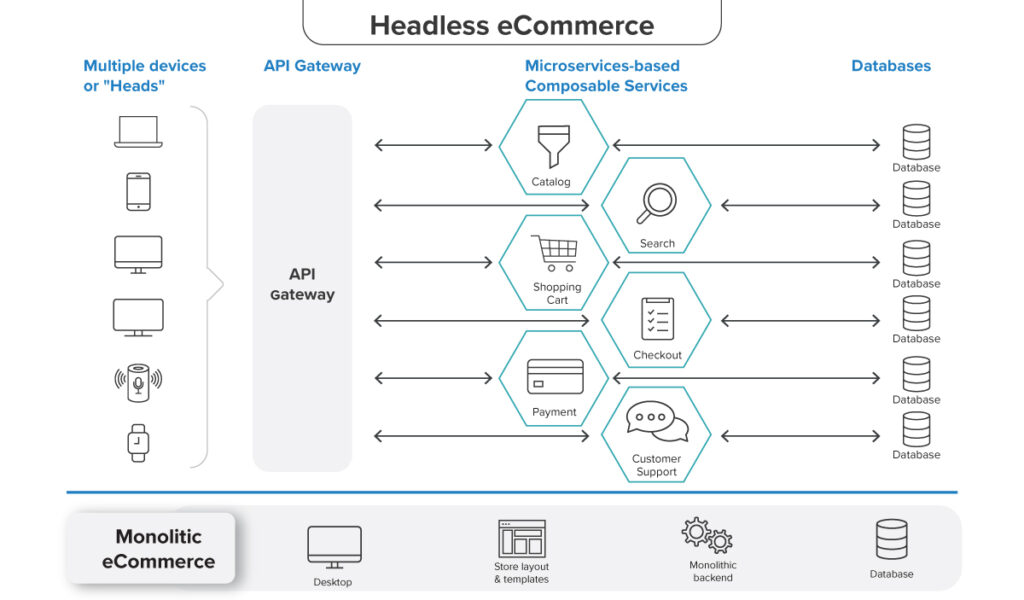Are you looking to boost your business’s agility, enhance customer experiences, and achieve a competitive edge in the digital marketplace? If so, then the combination of Microservices Architecture and Composable Commerce is your strategic ally. In this article, we will explore how these innovative approaches can directly benefit your business by enabling rapid adaptation to market changes, seamless scalability, and the creation of highly personalized and unique shopping experiences for your customers. Say goodbye to one-size-fits-all solutions and discover how Microservices and Composable Commerce can empower your business to thrive in the ever-evolving world of e-commerce.
Microservices Architecture champions the breakdown of complex applications into small, specialized services, each functioning independently and efficiently. Composable Commerce, in contrast, advocates for the assembly of e-commerce platforms from modular, customizable components. Together, they form a potent partnership, enhancing the agility, scalability, and personalization of e-commerce ecosystems.
Microservices, with their emphasis on decentralization and fault isolation, serve as the foundational building blocks upon which the Composable Commerce framework thrives. Each microservice corresponds to a specific commerce functionality, enabling businesses to offer dynamic, highly personalized shopping experiences while ensuring robust scalability. Whether it’s the rapid integration of new services, the swift response to market trends, or the seamless adaptation to evolving customer expectations, this union between Microservices Architecture and Composable Commerce positions businesses for sustained success in the digital era.
However, while this synergy offers a multitude of opportunities, it also presents critical considerations. Ensuring seamless communication between microservices demands clear API design and management. Scalability planning becomes vital, requiring businesses to design load distribution and resource allocation effectively. Effective monitoring tools are crucial for identifying and addressing potential issues promptly. Additionally, developing and managing microservices demands specialized skills, emphasizing the importance of training or partnerships with experts. In the following exploration, we delve deeper into this transformative relationship between Microservices Architecture and Composable Commerce, unlocking their potential to reshape the future of e-commerce.
Understanding Microservices Architecture

At its core, Microservices Architecture is an architectural style that involves breaking down complex applications into smaller, independent services, each focused on performing a specific business function such as Headless CMS. These services, or “microservices,” are designed to be loosely coupled, enabling developers to work on individual components without affecting the entire system. This granular approach to development not only facilitates faster iteration but also allows for better scalability and fault isolation.
The Essence of Composable Commerce
Composable Commerce takes the concept of modularity to the next level. Instead of relying on a monolithic e-commerce solution, businesses embracing Composable Commerce build their platforms using a collection of customizable components. These components, ranging from shopping carts and payment gateways to recommendation engines and inventory management systems, can be selected and combined like building blocks. This results in a tailor-made e-commerce ecosystem that aligns precisely with a business’s unique needs and customer demands.
The Symbiotic Relationship: Microservices and Composable Commerce
When Microservices Architecture and Composable Commerce converge, the result is a synergy that empowers businesses like never before. Microservices provide the technical foundation, offering individual building blocks that can be seamlessly integrated into the Composable Commerce toolkit. This union ensures that each microservice corresponds to a specific commerce functionality, enabling businesses to create dynamic and highly personalized shopping experiences.
Modernize your eCommerce platform
Advantages of Adopting Microservices in Composable Commerce
The benefits of adopting Microservices Architecture in Composable Commerce are manifold.
- Scalability: Microservices allow businesses to scale individual components independently, preventing bottlenecks and ensuring optimal performance even during high-demand periods.
- Flexibility: Composable Commerce enables businesses to mix and match components, ensuring that the platform can adapt to changing market trends and customer expectations without the need for extensive reengineering.
- Rapid Innovation: Microservices’ modularity fosters a culture of rapid innovation. Developers can work on microservices independently, leading to quicker feature development and time-to-market.
- Fault Isolation: Microservices’ isolated nature ensures that if one service fails, it doesn’t lead to a system-wide outage. This enhances the platform’s reliability and uptime.
- Customization: Composable Commerce allows businesses to create a bespoke e-commerce ecosystem, selecting components that align with their brand identity and customer experience goals.
Real-World Example of a Composable Microservices Architecture
While every business is unique, an illustrative example can shed light on the potential of Composable Microservices Architecture. Consider an online fashion retailer. By utilizing a recommendation engine microservice, they can offer personalized product suggestions to shoppers. A payment gateway microservice ensures secure transactions, while an inventory management microservice optimizes stock levels. Each of these microservices operates independently yet collaborates seamlessly, enhancing the overall shopping experience.
Modernize your eCommerce platform
As you embark on the journey of incorporating Microservices into your Composable Commerce strategy, several key considerations should be on your radar. These considerations, outlined below, will be your guiding light as you navigate this transformative path:
- Integration Complexity: Ensuring seamless communication between microservices demands robust API design and management.
- Scalability Planning: While microservices enable scalability, businesses must plan for load distribution and resource allocation.
- Monitoring and Management: Effective monitoring tools and strategies are crucial to identify and address potential issues promptly.
- Talent and Training: Developing and managing microservices requires specialized skills. Businesses must invest in training or consider partnering with experienced experts.
Conclusion: Paving the Way for Future-Ready E-commerce
Are you considering the adoption of Microservices within Composable Commerce? Here’s why you should:
- Scalability: Microservices enable each component of your platform to grow independently, ensuring optimal performance even during peak times.
- Personalization: You can craft tailor-made shopping experiences for your customers, enhancing their satisfaction.
- Adaptability: The agility of this approach means your platform can quickly adjust to changing market dynamics and shifting consumer preferences.
- Reliability and Innovation: Microservices enhance system reliability, as issues in one area won’t disrupt the entire platform. Plus, they foster innovation by streamlining the development process.
By integrating Microservices within your Composable Commerce framework, you’re setting your business up for sustained success in the dynamic digital realm.
Contact us today to embark on a journey of e-commerce transformation, where Microservices Architecture and Composable Commerce pave the way for your business’s future-ready success.

















